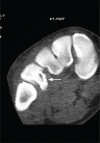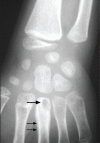Orthopaedic Manifestations of Date Thorn Injury: Case series
- PMID: 21748083
- PMCID: PMC3074855
Orthopaedic Manifestations of Date Thorn Injury: Case series
Abstract
Date palm thorn injuries are common in Middle Eastern countries where there are many date palm plantations. Most of the injuries happen to workers in the plantation or to children. Injuries, if detected, can be treated without subsequent complications, but in children the diagnosis can very easily be missed resulting in late complications. The hand, being the most exposed part of the body, is the most affected. Embedded thorns can produce lesions mimicking those of osteomyelitis. The foot is exposed to injuries in people who walk barefoot in the plantations. The author presents five cases of date thorn injury which presented with late complications. All three patients with hand injuries had periostitis, and one of them had an intraosseous thorn producing osteomyelitis. Two patients presented with osteolytic lesions of the metatarsals with intraosseous thorn in one patient. All cases recovered completely leaving behind no sequlae of the bony infection.
Keywords: Bone cyst; Case Report; Foreign body granuloma; Hand; Metatarsal; Oman; Osteomyelitis; Periostitis.
Figures





References
-
- Barry M, Maffulli N, Good C. The missed thorn. Acta Orthop Belg. 1992;58:468–470. - PubMed
-
- Suresh SS. Date thorn infections of the hand in children. J Hand Surg (Eur) 2008;33:227–329. - PubMed
-
- Balasubramaniam P, Prathap K. Pseudotumous due to oil palm thorn injury. Aust N Z J Surg. 1977;47:223–225. - PubMed
-
- Brady RC, Sommerkamp G. Thorn induced alteraria flexor tenosynovitis of the hand. Pediat Inf Dis J. 2001;20:1097–1098. - PubMed
-
- Diog SG, Cole WG. Plant thorn synovitis: Resolution following total synovectomy. J Bone Joint Surg. 1990;72B:514–515. - PubMed
LinkOut - more resources
Full Text Sources
